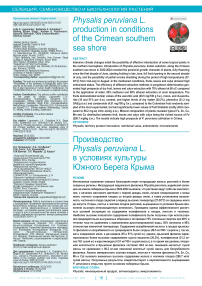Physalis peruviana L. production in conditions of the Crimean southern sea shore
Автор: Logvinenko L.A., Golubkina N.A., Singh R.Sh., Koshevarov A.A., Shevchuk O.M., Murariu O.C., Caruso G.
Журнал: Овощи России @vegetables
Рубрика: Селекция, семеноводство и биотехнология растений
Статья в выпуске: 3 (83), 2025 года.
Бесплатный доступ
Intensive climate changes entail the possibility of effective introduction of some tropical plants in the northern hemisphere. Introduction of Physalis peruviana, Indian selection, along the Crimean southern sea shore in 2022-2024 revealed the perennial growth character of plants, fully flowering since the first decade of June, starting fruiting in late June, full fruit ripening in the second decade of July, and the possibility of partial ovaries shedding during the period of high temperatures (2730°С) from mid-July to August. In the mentioned conditions, fruits, leaves and calyx showed high antioxidant status. The efficiency of different extraction methods in polyphenol determination generated high prospects of dry fruit, leaves and calyx extraction with 70% ethanol at 80 oC compared to the application of water, 50% methanol and 98% ethanol extraction at room temperature. The fruits demonstrated similar values of the ascorbic acid (48.5 mg/100 g f.w.), monoand di-saccharide (35 and 51% per d.w.) content, and higher levels of dry matter (20.2%), phenolics (21.2 mg GAE/g d.w.) and carotenoids (4.51 mg/100 g f.w.), compared to the Colombian fruit randomly sampled at the local supermarket, but had significantly lower values of fruit titratable acidity (49.0 compared to 86.2 mg-eq citric acid/g d.w.). Mineral composition of plants revealed typical Fe, Zn, Cu, Mn and Co distribution between fruit, leaves and calyx with calyx being the richest source of Fe (288.7 mg/kg d.w.). The results indicate high prospects of P. peruviana cultivation in Crimea.
Physalis, territory product innovation, nutritional value, antioxidants, microelements
Короткий адрес: https://sciup.org/140310380
IDR: 140310380 | DOI: 10.18619/2072-9146-2025-3-16-25


